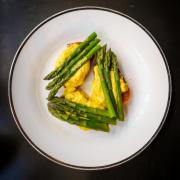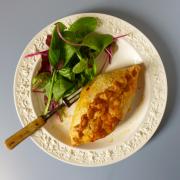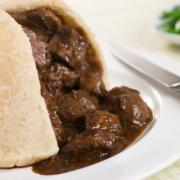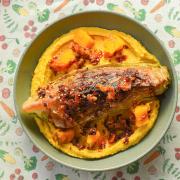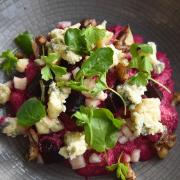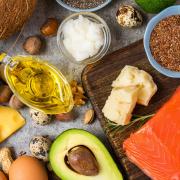The kitchen coldstores are bulging with walled garden produce for Somerleyton’s chef-director Stephen David

Being at the centre of a busy farming enterprise has opened my eyes even further to how dependent we chefs are on picking up the phone and, without a thought, waiting for the ingredients to come in, clean, shrink-wrapped and pre-¬portioned. I’m not sure many of my peers stop to think that cows are born with four legs rather than as vacuum packed steaks, chickens have legs and wings too, or that asparagus is often bendy.
On the continent, kitchens and menus are far more driven by what’s in season and on the market, rather than the chef’s shopping list of particular cuts or prepared products. I’m just realising how blessed I am with what we harvest in house on the estate at Somerleyton.

Much of my focus this month has been on understanding the ethos and possibilities of the home-grown produce from the pretty spectacular Grade I listed grounds surrounding the hall, with its Paxton designed glasshouses, formal beds and verdant borders, and especially our kitchen gardens, all managed by head gardener Anna Outlaw and her team. The kitchen gardens account for one acre of the 12¬acres of mostly ornate landscaped grounds, so it’s impressive how they produce so much produce from a relatively small space.
The contrast in the wilder more natural looking kitchen gardens to the well clipped formal terraces demonstrates Anna’s hands-off ecological approach – she’s a qualified conservationist as well as landscape gardener – intentional uncut pockets providing lush wildflower strewn habitat for wildlife, protected by minimal use of chemicals in the spirit of the estate’s greener agricultural intent. As a chef on the receiving end, I’m a firm believer that slower grown, more natural crops, not forced with artificial fertiliser nor sanitised by spraying, can only taste better and be healthier for us.

Behind the garden walls
I have been taking advantage of the great spell of sunshine and blue skies to get hands-on in the kitchen gardens – well walking, talking and tasting with Anna – to get a sense of how best to harness this bounteous source of provender and hear what we should be cooking. Clearly it is about what grows well.
“There’s little point planting cheap bulk crops like roots, potatoes and onions,” says Anna. “It’s best we specialise in artisan and expensive ingredients – things like micro salads – that’s baby leaves and pea shoots for garnish – herbs, berries and exotics like globe artichokes, rainbow chard and cavalo nero. Where we do grow more predictable things, to look towards the more flavoursome and interesting like the multi¬coloured beetroots or unusual fruit like tayberries.

“The kitchen garden was actually mothballed post-war, so I came across it pretty much fallow three years ago when I arrived, and it’s only in the past two growing seasons that we’ve have had it back in proper production. There’s no topsoil in places, so we grow in potato crates as raised beds. We’re still learning what will thrive.
“The estate’s new drive to minimise food miles and to be as self-sufficient as possible means an exciting period of development over the next few years, emphasising seasonality, taste, ease of growth, and not costing the earth, literally! Our produce makes a big talking point on the chefs’ menus at The Duke’s Head and The Fritton Arms.”
Walking around the grounds, my eyes were opened to what was going to be soon turning up in our kitchens.
“August and September are so plentiful,” says Anna. “Lots of courgettes, beans like runner, borlotti and French, quirky salads and greens like kale, banana shallots, early autumn squashes, herbs, berries and of course all the old fruit trees are laden, heirloom pears and apples, an ancient quince and delicious plums. Our walled gardens do give an amazing microclimate, holding on to the warmth at nights and sun kissed during the day. In fact, the glasshouses are too hot to use much, apart from for figs and citrus fruits at the height of summer.”
I took inspiration from our colourful produce, combining colour and texture with flavour to whip up an elegant quirky salad. And as you can never have too much of a good thing, five other quick unusual seasonal alternatives:
• ¬Courgette ribbons, green beans, peas, shredded mint and tarragon crème fraîche
• Scorched rainbow chard, baby beets, goats curd, red wine poached pear and watercress
• ¬Carrot ribbons, toasted cumin seeds, fennel tops, burnt oranges, harissa chilli dressing
• ¬Heritage tomato, shallots, basil leaves, capers, anchovies and roast garlic cloves
• ¬New potatoes, roasted peppers, local chorizo, dried tomatoes, white beans, smoky paprika and parsley
Try making your own home¬made salad cream, a much tastier to the usual bottled variety.
In a food processor, blend 150 ml double cream, 50ml Aspall cyder vinegar, 1 tbsp caster sugar, juice of half a lemon, 2 tbsp good local mustard and 2 hard¬boiled egg yolks (organic, free range) until it starts to thicken and then pour in a very gentle stream of 150ml rapeseed oil.
Super salad:
Charred radicchio, spring onion, pickled walnut and quails egg salad with creamy blue cheese and apple dressing
Rustic wholemeal loaf
Rapeseed oil
Sea salt and black peppermill
1 small garlic clove, grated
1 Cox apple
Aspall cyder vinegar
6 tbsp home¬made salad cream
100g local blue cheese, crumbled
3 head of radicchio
8 spring onions
4 pickled walnuts, sliced into rings
5 Norfolk quails’ eggs, hard¬boiled
Handful pea shoots
Handful wild rocket
Method:
Pre¬heat the oven to 200c. Tear rough inch size pieces of the bread and toss with a good drizzle of oil, seasoning and the garlic, before baking until toasted and crisp, approx. 10 – 15 minutes. Remove and cool.
Next make the dressing by grating the apple and tossing in a little vinegar. Mix into the salad cream with the cheese and adjust seasoning. Loosen with vinegar if needed to a thick pouring consistency.
Slice the radicchio into thin wedges, lengthways through the stem. Brush with oil and season. Cook on a very hot char grill until well marked and set aside. Halve the spring onions lengthways and char in a smoking flat griddle pan to burn the edges.
Build your salads by laying out radicchio, scatter with pea shoots and rocket, lay over onions, scatter around croutons, walnuts and halved eggs, before drizzling with the dressing. Enjoy!




